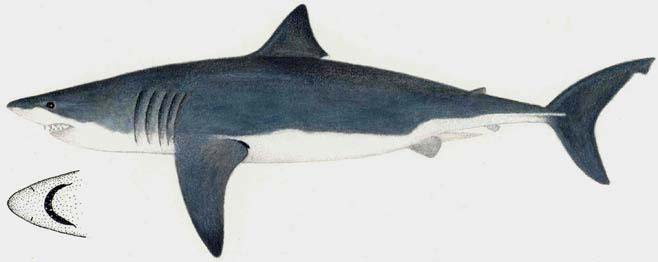|
Carcharodon carcharias (Great white shark)
(Linnaeus, 1758)
Life
> Eukaryotes >
Opisthokonta
> Metazoa (animals) >
Bilateria >
Deuterostomia > Chordata >
Craniata > Vertebrata (vertebrates) > Gnathostomata (jawed
vertebrates) > Chondrichthyes >
Elasmobranchii > Galeomorphii > Lamniformes >
Lamnidae
 |
|
Carcharodon carcharias (Great white shark) [Illustration
by Ann Hecht ©] |
Identification
A huge, spindle-shaped shark with small
conspicuous black eyes, blunt conical snout, and large, triangular,
saw-edged teeth. Colour lead grey to brown or black above, lighter
on sides, abruptly white below, a black spot at rear pectoral base.
Size
To 7.1 m TL.
Range
Almost entire coast from Namibia to Natal;
all temperate and tropical seas.
Habitat
Coastal and offshore, surfline and shallow bays to offshore islands, surface to 1280 m
depth.
Biology
An active, swift, powerful shark that can leap out
of the water. Eats bony fish, sharks and rays, seals, dolphins and
porpoises, sea birds, carrion, squid, octopi, and crabs. Bears 7 to
9 young.
Human Impact
A potentially dangerous species that
infrequently attacks divers, swimmers, surfers, and boats; often
investigates divers and boats without attacking. Caught by big-game
anglers, by the Natal shark nets, and by lineboats for its jaws. Text by Leonard J.V. Compagno, David A. Ebert
and Malcolm J. Smale |
